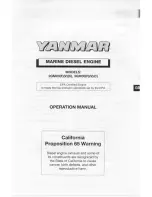
Engine Overhaul Manual
Jabiru Aircraft
Pty Ltd
Jabiru 2200 & 3300 Aircraft Engines
This document is controlled while it remains on the Jabiru server. Once this no longer applies the document becomes uncontrolled.
ISSUE
1
2
3
4
5
6 7
Dated : 28/10/2014
Issued By: AS
Page: 130 of 201
L:\files\Manuals_For_Products\Engine_Manuals\Overhaul_Manual\JEM0001-7_Overhaul_Manual_DRAFT_(29_10_14).docx
7.8.3 Setting Cam Timing
Figure 160
– Measuring Top Dead Centre
In newer engines the datum marks on the gears are invariably accurate, however timing must still be
checked in case older parts are being used.
Fit a mount plate and dial gauge to cylinder #1 of the engine and use the dial gauge to accurately locate
top dead centre for that cylinder. This is done by using the dial gauge to estimate TDC then bending
the wire to point at 0° on the degree wheel. Then rotate the engine to the right (against rotation) until
the dial gauge records movement of 0.5mm from TDC and record the degree wheel reading. Move the
engine back to 0° then turn it to the left until the gauge reads 0.5mm
– record the degree wheel reading.
Calculate the centre point between these two readings
– this is the true TDC for this cylinder. The
engine can then be rotated until the wire points at this reading and the wire re-bent to point at 0°. Care
must be taken from now on not to bend the wire! Double-check this position by repeating the above
procedure
– twisting to the left, then to the right.
Rotate the cam until the two timing marks on the large cam gear are pointing towards the crankshaft.
The camshaft drive gear can now be fitted to the end of the crank as shown in Figure 161
– so that the
tooth on the crankshaft gear with the timing mark is between the two teeth of the cam gear with timing
marks.
A single cap screw can now be added to the crankshaft gear to lock it in place relative to the crankshaft.
Once this is done the timing must be checked by reading directly from the camshaft.
For a hydraulic lifter engine
– for measurement purposes – fit a hydraulic lifter to the lowermost port of
the engine (as shown in Figure 162
– alternatively a special tool such as that shown in Figure 29 can be
used).
Now rotate the engine to find the point of maximum lift of the cam lobe being checked. The procedure
here is the same as for finding TDC for the cylinder
– with the exception that the timing pointer wire
must not be bent! Estimate the point of max lift for the cam, then turn the engine either way until the
dial gauge records 0.5mm movement. Record the timing readings and calculate the centre point.
Peak lift occurs about 70
– 72° after Bottom Dead Centre (71° typical) for the exhaust lobe and 68 – 72°
(71° typical) before Bottom Dead Centre for the intake lobe.
Dial gauge mount plate
Wire indicator adjusted to TDC
















































